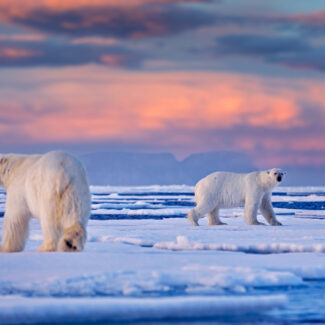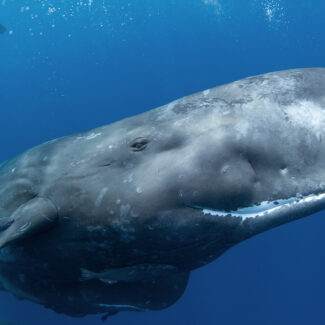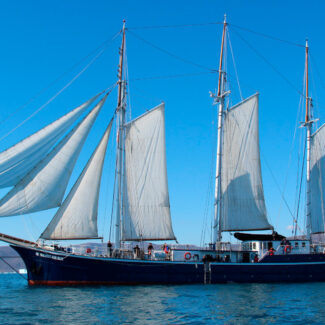Do Polar Bears Live In Antarctica?
Do polar bears live in Antarctica? No! That settles that matter, right? Well, actually, the absence of polar bears from the southern polar realm offers an interesting exploration of biogeography and the similarities and differences that exist between the Arctic—the polar bear’s H.Q.—and the Antarctic.
The possibility of polar bears eventually inhabiting the Antarctic, via the conservation-minded intervention of humankind, has been floated though. So whilst the population of polar bears in Antarctica is currently zero, that’s not to say it will always be. Let’s dig a little deeper into the subject of the Ice Bear and its prospects of populating the White Continent.
Polar Bears in Antarctica—Not!
It’s not at all uncommon for folks to mistakenly believe polar bears inhabit Antarctica. That impression may be instilled or perpetuated by the preponderance of cartoon and other imagery showing the great white bear rubbing shoulders with penguins. Given these are both mighty charismatic, almost universally familiar animals and given they both may be the most “quintessential” critters of the polar realm in the popular imagination, that’s maybe not surprising. It is, however, altogether inaccurate and misleading. Polar bears are restricted to the Arctic, and penguins—which, as a family, are not tied to the polar zone—are almost exclusively found in the Southern Hemisphere. The one exception, the Galapagos penguin, inhabits the tropical Pacific still thousands of miles from the nearest polar bear.
The stubborn resilience of the myth that polar bears can be found in Antarctica calls to mind another common, long-standing misconception about a charismatic carnivore: that tigers—which, in actual fact, are restricted to Eurasia—can be found in Africa. (It’s the lion, in fact, that inhabits both Eurasia and Africa, though it only clings to existence in a tiny fraction of its Asiatic range. But we digress…)
While this image showcases the incredible beauty of polar bears, it’s a common misconception that they live in Antarctica! These magnificent creatures are exclusive to the Arctic, so you won’t find them roaming the icy landscapes of the South Pole.
Why Don’t Polar Bears Live in Antarctica?
There’s a very simple reason for the polar bear’s absence from Antarctica: It evolved in the Northern Hemisphere a mere few hundred thousand years ago—which means a couple hundred million years or so after Antarctica was last connected to the northern continents via the prehistoric supercontinent of Pangea.
The bear line itself only arose 20 or 30 million years ago in North America and Eurasia, after or not long before Antarctica became a completely standalone landmass: separated from its Gondwanan sibling South America, riding tectonic plates poleward, and well on its way to being swamped in ice. No land bridge existed to allow even the most ancient bears to colonize Antarctica, let alone the evolutionary whippersnapper that is the ice bear.
How Far South Do Polar Bears Go?
In a rough inverse of the penguin clan, bears are predominantly a Northern Hemisphere group, though they did spread into South America from North America, and one survivor of that once-more-diverse South American ursid lineup persists in the form of the spectacled or Andean bear. In addition, the range of the sun bear, a tropical species of Southeast Asia, extends below the equator in Indonesia.
Today, polar bears are a circumarctic beast inhabiting the Arctic coast and archipelagos of Alaska, Canada, Greenland, Norway, and Russia and the adjacent Arctic Ocean ice. The farthest south that polar bears are known to live all year round is James Bay in Canada, on approximately the same latitude as London, England. However during winter, when the Arctic polar ice pack extends further south, polar bears have been spotted as far south as Newfoundland and into the northern Bering Sea. But, that’s still just about as far away from Antarctica as you can get!
Can Polar Bears Live in Antarctica?
Likely descended from brown-bear ancestors less than 500,000 years ago, the polar bear is a youthful species that’s adapted marvelously in short order to the High Arctic. White-furred, padded with warming fat, possessed of semi-webbed paws with short, sharply curved claws ideal for clutching ice and pinniped alike, the polar bear is classed as a true marine mammal, given it spends much of its life roaming the offshore sea ice.
The most devotedly carnivorous of the bears, polar bears stalk a variety of prey in and around the Arctic Circle, feeding on everything from bird eggs and lemmings to caribou and muskoxen. Their primary prey, however, is marine mammals, and while polar bears will attack species as large as beluga whales, narwhals, and walruses, Arctic seals—bearded, ringed, hooded, and others—are their true bread-and-butter.
Polar bears in the Arctic
Top predators in the Arctic, polar bears would surely occupy that niche if somehow magically transported to the Antarctic, where they could undoubtedly survive and very likely prosper along parts of the coast and the sea ice. Seals, after all, are spectacularly abundant in Antarctica, and penguins—as we’ve demonstrated, entirely unavailable to polar bears in their natural range—would make easy pickings as well.
Polar bears face an uncertain future in the Arctic, subjected as it is to rapidly warming temperatures and diminishing sea-ice extent. Some have raised the extreme idea of releasing the animals in Antarctica—also, of course, showing substantial impacts from climate change, but generally host to healthier and more extensive ice cover—as part of a long-term conservation strategy for the species.
That’s a notion most scientists cast a dubious eye upon. Humans “playing God” doesn’t tend to go well, overall. And the introduction of polar bears to Antarctica, where ecosystems have evolved for millions of years without a large terrestrial predator, would be hugely disruptive. Antarctic seals show little of the caution and evasive behavior when hauled out that Arctic seals must, given the polar bear’s presence. These pinnipeds—as well as similarly naive penguins, especially onshore—would likely be sitting ducks for the ice bear.
And the polar bear would be competing directly with the Antarctic’s two major native top predators, the orca (which it overlaps with in the Arctic) and the leopard seal. The ripple effects of an Antarctic population of polar bears throughout the food web would surely be extensive—and unpredictable.
The Magic of the (Bear-Free) Antarctic Zone
Polar bears are wondrous beasts, and we’re lucky to share the planet with them (for now). If you want to see one, though, you’re steering your way north—way north—to the Arctic Circle. The near-pristine, intensely remote Antarctic, meanwhile, has its own dazzling roster of native wildlife, including what might be considered (very roughly) the “polar bear of the Southern Ocean”: that toothy, thick-jawed, pugnacious leopard seal.
A cruise to the Antarctic Peninsula, not to mention the sub-Antarctic islands, ranks among the preeminent wildlife-watching experiences in the world—even if you won’t find the great white bear on the White Continent!
While polar bears are absent from the Antarctic, the “bear-free” zone boasts its own incredible magic! Instead of polar bears, you’ll be captivated by vast colonies of penguins, playful seals, and majestic whales, creating an unforgettable wildlife spectacle unique to the southernmost continent.
Disclaimer
Our travel guides are for informational purposes only. While we aim to provide accurate and up-to-date information, Antarctica Cruises makes no representations as to the accuracy or completeness of any information in our guides or found by following any link on this site.
Antarctica Cruises cannot and will not accept responsibility for any omissions or inaccuracies, or for any consequences arising therefrom, including any losses, injuries, or damages resulting from the display or use of this information.










